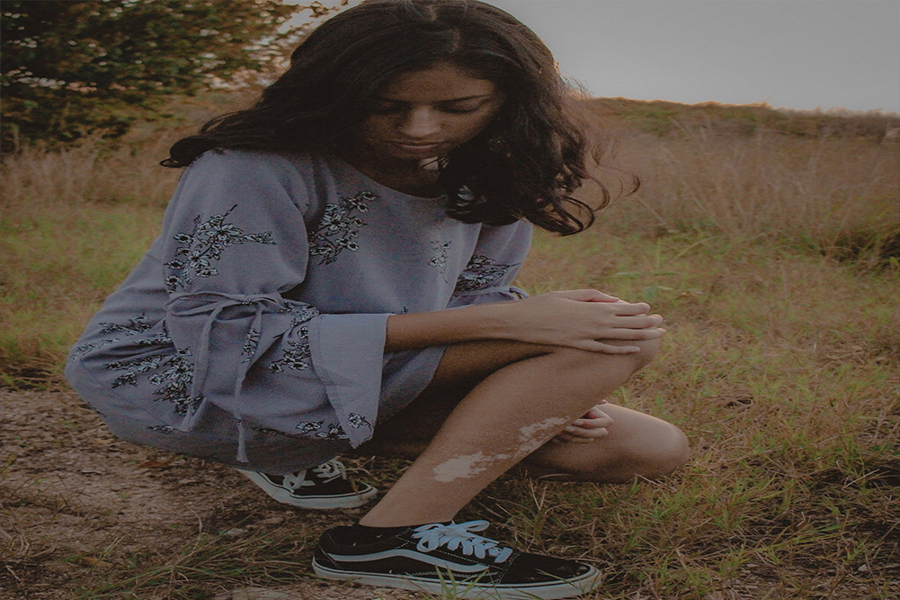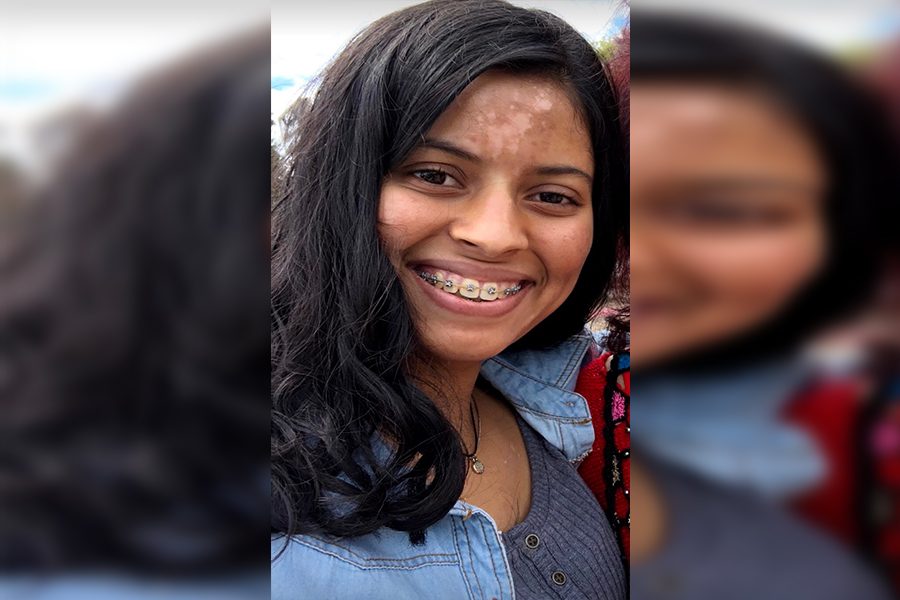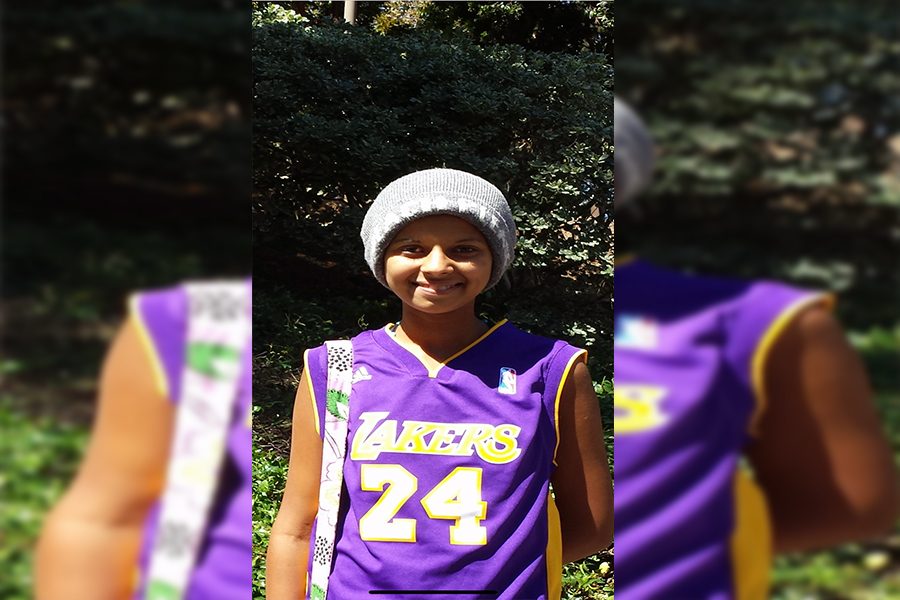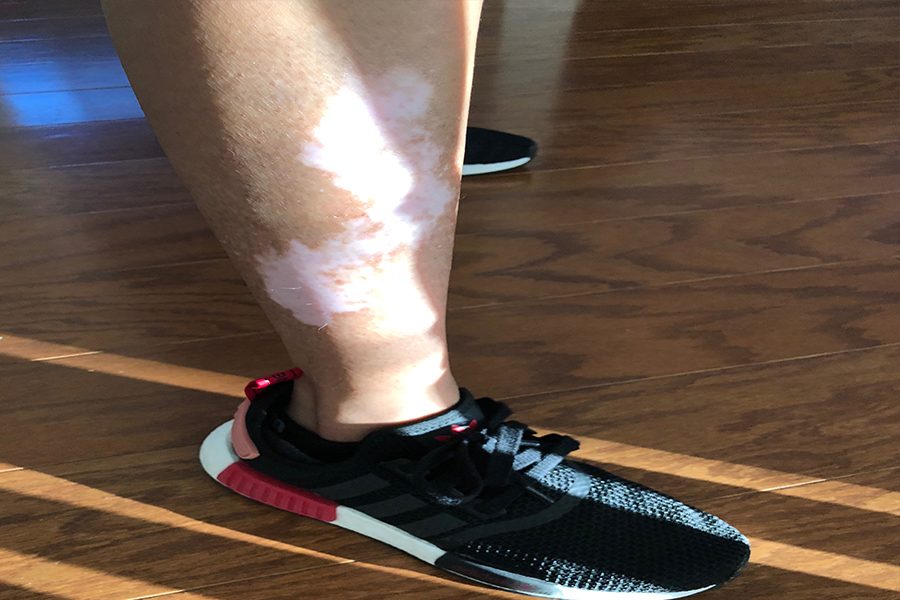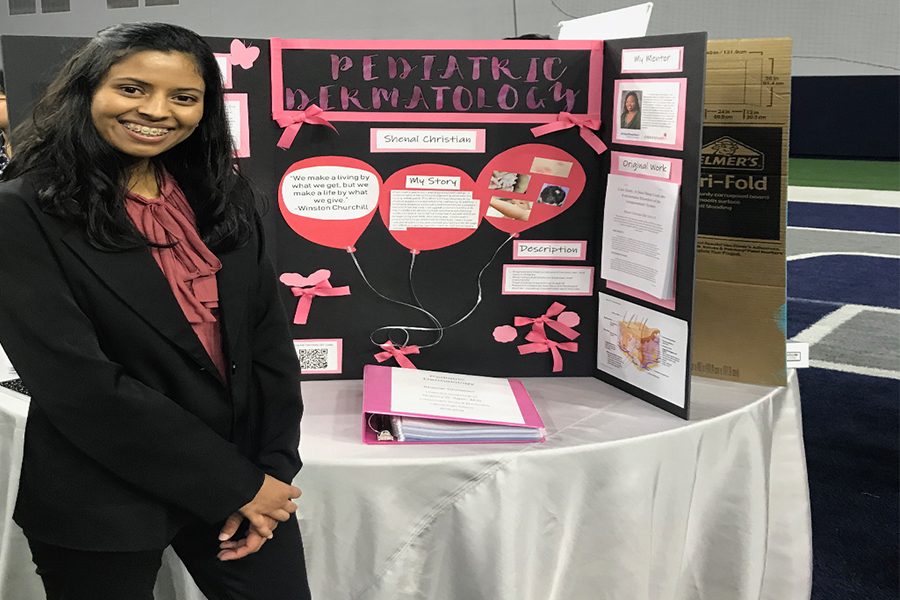Shenal’s story
Surviving being thrown in the deep end
April 5, 2019
“You are not beautiful. It’s disgusting”
“Cut out your skin. Scrape it out”
“You look like a cow”
“Are you contagious?”
“No one cares enough about you let alone how ugly your skin makes you look”
“Is that how you’re going to look like forever?”
“Are you Indian or are you white?”
“You should cover that stuff up before others see”
“Can you become attractive later on even with vitiligo?”
These are just some of the questions faced by guest contributor, senior Shenal Christian as she grew up. Overcoming a diagnosis of vitiligo at a young age, followed by a diagnosis of alopecia areata years later, Shenal shares her story.
After coming back from swimming when she was in elementary school, senior Shenal Christian’s mom found a white spot on her leg that she had not noticed before. This small spot turned out to be vitiligo, which Christian was later diagnosed with.
Learning to swim
My whole life I had felt scared. I was scared of the unknown and what would come out of not knowing enough. I feared that people would look at me and run away. I believed my spots would keep me from being the best version of myself. Most of all, I was terrified that my condition would be insurmountable and I would be forever limited by it.
My name is Shenal Christian and I have vitiligo.
When I was in elementary school, my friends and I wanted to learn how to swim and I begged and pleaded with my parents to sign me up so that I can hang out with my friends. Every other day after school we would go to Emler Swim School and learn the basics of swimming. I was very excited to get in to the pool, and would often be the first one in the water. It reminded me of growing up on the beaches of California when I was younger and how I felt one with the water.
One day, my mom noticed a white splotch on my right leg, about the size of a quarter and she tried to rub it out with soap and water, to no avail. She grew worried and researched what to do. My world shattered when I went to the dermatologist for the first time and was diagnosed with vitiligo.
Hearing there was no cure, I was no longer going to be the bubbly little girl I once was. My days would be spent going to light therapy and avoiding sunlight. I could no longer swim or hang out with my friends. Worst of all, I was not myself, I was changing colors.
I felt like a chameleon. The spot on my leg grew like wildfire. It spread to my other leg and back, arms, groin, wrists, chest, elbows, the inside of my lip, and my ear. I was 60 percent white.
I felt alienated from my family, who were Indian by heritage, and my friends, who were only one skin color. I would wear turtlenecks and tights and jeans in the summertime and kids would laugh at me.
I never dared to wear a dress. I could not go swimming or go to the beach. I quit dancing. I hated going out, for fear that people would look at my arms and get scared of “catching” whatever I had.
Kids who did see the spots would say “ewwww gross” and run away. Parents would ask if my condition was contagious and teachers would call me up to talk to them.
I did not understand why my body’s cells were attacking themselves. I had taken excellent care of my skin ever since I was young. I would moisturize and put on sunscreen and avoid touching too many things. I was thrown into the deep end with no way out and no knowledge of how to swim or float.
Following her diagnosis of alopecia universalis, senior Shenal Christian lost hair from various parts of her body; from her legs, to her eyebrows, to her eyelashes.
The haircut
After living with vitiligo for six years, I entered remission making me feel as I had finally reached the surface, getting the oxygen I desperately needed after feeling like I had been drowning.
There were brown spots within the patches of white on all the areas affected, however the spots had not receded and were not growing. I was surprised that a disease as noticeable as this was sparing my face and arms from the world. I felt at ease that my spots could be easily covered and that no one would ever know.
As I was preparing for middle school, I wanted to get my hair cut. As the lady was cutting my hair, she noticed a bald patch on the back of my head and alerted my parents.
Back to the dermatologist we went and another diagnosis. This time: alopecia areata, a disorder where the body’s immune cells mistakenly attack the body’s hair follicles. I was destroying myself yet again. I fell into a hole. I could not handle life being bald AND spotted.
As I combed my hair every morning, clumps would fall out and every time I touched my hair, strands would come out in my hands. By November 2013, I could not even comb my hair or even tie it up in a bun. I told my mom to shave my head. All of it. There was no point in keeping something that was never going to last.
I was bald.
I was crushed.
And I felt hideous.
During Thanksgiving break, my parents took me to All About You Wig Boutique and Cancer Recovery Salon. There, a stylist picked out a wig for me and dyed it to match my previous hair color. Nothing mattered to me anymore.
As I walked in to school with my wig on, people LIKED it. I got so many compliments that first day. People had assumed that I had gotten extensions and changed my hair style. They still did not know I had alopecia. Some days were harder than others. Sometimes, I would want to rip out my hair and throw it across the room and other days I would wear a beanie and cry until I couldn’t breathe and get sick to my stomach.
By January 2014 I had lost my leg hair, eyelashes, and eyebrows as I had a new diagnosis: alopecia universalis.
My morning routine consisted of using an eyebrow filler, putting on my wig cap and wig, covering up the stray hairs with brown mascara, and putting cosmetic makeup on my facial vitiligo.
It was a reality for me that I was DIFFERENT.
I never told anyone that I had these diseases because I feared exposure would limit my opportunities. I felt as if I would lose everything I had because of these diseases.
For four years, the wig was my source of comfort and normalcy. Without it, I would revert to my OCD self and get anxiety. Above all, I was depressed.
I was a middle schooler in a new school who could not go to sleepovers and was never asked to a school dance because my hair always looked the same and I wore too much makeup to cover up my scarring. People used to think that I tried too hard.
The most painful thing someone has ever said to me was that God would be ashamed of the person I had turned into because of the facade I had created for myself. I was ashamed of myself until sophomore year of high school.
Ever since she was a little girl, senior Shenal Christian had spots of white covering her body. These sports turned out to be vitiligo, which she was diagnosed with at a very young age.
Underwater
One of the treatments used to control the growth of vitiligo is called Narrowband UVB therapy. Every other day after school, my mom would pick me up and drive me to my dermatologist’s clinic. Once there, I would undress completely, step in to a four door box with lamps inside as part of the therapy. Before I would step into the “sun booth” as I liked to call it, I would do a quick prayer because I was scared that the box would take away my eyesight and as a precaution I would wear eye goggles and close my eyes super super tight. My mom would smother sunscreen onto my face and I would step in.
I never told this to anyone before, but I would cry every time I was in the therapy booth. Those six minutes and 30 seconds felt like I was close to the sun and if I opened my eyes, I would get sucked in.
I HATED the sun booth. I hated the days I would be forced to go. I hated my unsightly, spotted skin. I hated the kids who asked what was wrong. I hated my doctors for not fixing me. I hated people who had clear skin and a perfect life. I hated myself.
I developed obsessive compulsive disorder two years after I was diagnosed.
My hand would compulsively scratch my spots, making them inflamed and red. My nails dug into to the inside of my palms every time I was in the box and counting to 300 was my only outlet from the pain.
Counting my steps was the only release from having to talk to other kids on the playground and wearing pants every single day became a routine.
Every time I closed my eyes, I felt like I was underwater. I was drowning.
At one of her ISM conventions, senior Shenal Christian smiles in confidence as her hair has 100% recovered. She hopes to pursue a career in pediatric dermatology in the future to help provide support for children who going through similar conditions to what she has experienced.
Diving in
For my 16th birthday, my family surprised me with a trip to Mexico. As I saw the ocean, in its vast nature, I felt safe. I did not wear my wig and I bought my first pair of shorts. I ran into the ocean and took a deep breath. I FELT ALIVE and new and cleansed. I prayed to God that night thanking him for that experience.
When we returned, I went to school without a wig for the first time in five years. I loved who I was and I felt BEAUTIFUL.
I stopped filling in my eyebrows and I cried tears of joy every time I saw myself in the mirror. My pixie cut made me feel like a princess. Within two months, my hair was down to my shoulders, my eyebrows grew again, my legs started growing hair again, and my spots were filling in.
My vitiligo had receded down to about 15 percent of my body. I started going to church regularly and started buying dresses. I went out regularly with friends and went swimming. I no longer had OCD and I had less anxiety about going to school.
But now I understand why this happened to me. It was a detour on life’s road that is leading me to my final destination. I am going to be a pediatric dermatologist to help children who are facing similar conditions as I have in the past and a be a source of support and reason for them. I want to research and treat these diseases. I want to help and I will cure these conditions.
Today, I am 18 years old with a patch on my right leg and scars on my left. I have a full head of hair, three years in the making.
I am restored and whole.
I am swimming laps.
I share my story because there are people that I sit next to in my classes who are facing issues that we may not understand. People in our midst are struggling with problems that others may not struggle with. Respect everyone and compliment others, it would mean the world to them. Every single person is beautiful and they are not alone.
